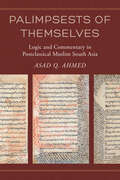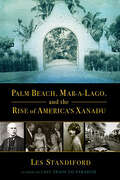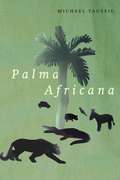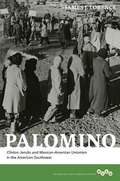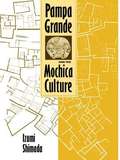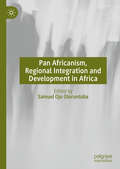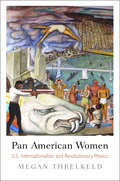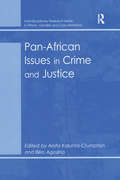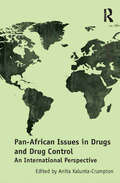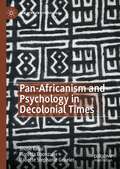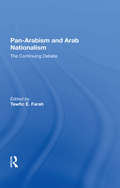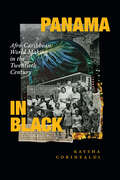- Table View
- List View
Palimpsests of Themselves: Logic and Commentary in Postclassical Muslim South Asia (Berkeley Series in Postclassical Islamic Scholarship #5)
by Asad Q. AhmedA free open access ebook is available upon publication. Learn more at www.luminosoa.org.Palimpsests of Themselves is an intervention in current discussions about the fate of philosophy in postclassical Islamic intellectual history. Asad Q. Ahmed uses as a case study the most advanced logic textbook of Muslim South Asia, The Ladder of the Sciences, presenting in English its first full translation and extended commentary. He offers detailed assessments of the technical contributions of the work, explores the social and institutional settings of the vast commentarial response it elicited, and develops a theory of the philosophical commentary that is internal to the tradition. These approaches to the commentarial text complicate presuppositions upon which questions of Islam’s intellectual decline are erected. As such, Ahmed offers a unique and powerful opportunity to understand the transmission of knowledge across the Islamic world.
Palliative Care im Fokus von Supervision: Eine Ethnografisch-partizipative Untersuchung Von Palliativ- Und Hospizteams
by Ursula HermannUrsula Hermann geht den Fragen nach, wie Hospiz- und Palliativteams ihre beruflichen Anforderungen erleben und welche Themen sie in der Supervision zur Sprache bringen. Dafür untersucht sie das Feld der Hospiz- und Palliativversorgung mithilfe des Beratungssettings Supervision. Die ethnografische Methode der teilnehmenden Beobachtung gewährt Einblicke in Beratungsprozesse, die partizipative Forschungsstrategie ermöglicht eine Teilhabe an den Forschungsergebnissen für Supervisandinnen und Supervisanden. Die Erfahrungen und Handlungspraktiken der Berufsgruppen machen deutlich, welche Themenvielfalt sich in der Betreuung und Versorgung von Sterbenden und schwer kranken Menschen zeigt und welche Herausforderungen eine organisationale Einbettung von Palliative Care mit sich bringt.
Palm Beach, Mar-a-Lago, and the Rise of America's Xanadu
by Les StandifordFrom the first Gilded Age to the second, a “charming, zippy history . . . a rollicking, informative lesson in real estate, American history, and current events.” —Town & CountryLooking at the island of Palm Beach today, with its unmatched mansions, tony shops, and pristine beaches, one is hard pressed to visualize the dense tangle of Palmetto brush and mangroves that it was when visionary entrepreneur and railroad tycoon Henry Flagler first arrived there in April 1893. Trusting his remarkable instincts, he built the Royal Poinciana Hotel within a year, and two years later, what was to become the legendary Breakers—instantly establishing the island as the preferred destination for those who could afford it. Over the next 125 years, Palm Beach has become synonymous with exclusivity—especially its most famous residence, Mar-a-Lago. As Les Standiford relates, the high walls of Mar-a-Lago and other manses like it were seemingly designed to contain scandal within as much as keep intruders out.This book tells the history of this fabled landscape intertwined with the colorful lives of its famous and infamous protagonists, from Flagler’s two wives to architect Addison Mizner, who created Palm Beach’s “Mediterranean look” to heiress Marjorie Merriweather Post and her husband E. F. Hutton, the original residents of Mar-a-Lago. With authoritative detail, Standiford recounts how Marjorie ruled Palm Beach society until her death in 1973, and how the fate of her mansion threatened to tear apart the very fabric of the town until Donald Trump acquired it in 1985.“Edifying, energetic, and captivating.” —Florida Weekly
Palma Africana
by Michael Taussig“It is the contemporary elixir from which all manner of being emerges, the metamorphic sublime, an alchemist’s dream.” So begins Palma Africana, the latest attempt by anthropologist Michael Taussig to make sense of the contemporary moment. But to what elixir does he refer? Palm oil. Saturating everything from potato chips to nail polish, palm oil has made its way into half of the packaged goods in our supermarkets. By 2020, world production will be double what it was in 2000. In Colombia, palm oil plantations are covering over one-time cornucopias of animal, bird, and plant life. Over time, they threaten indigenous livelihoods and give rise to abusive labor conditions and major human rights violations. The list of entwined horrors—climatic, biological, social—is long. But Taussig takes no comfort in our usual labels: “habitat loss,” “human rights abuses,” “climate change.” The shock of these words has passed; nowadays it is all a blur. Hence, Taussig’s keen attention to words and writing throughout this work. He takes cues from precursors’ ruminations: Roland Barthes’s suggestion that trees form an alphabet in which the palm tree is the loveliest; William Burroughs’s retort to critics that for him words are alive like animals and don’t like to be kept in pages—cut them and the words are let free. Steeped in a lifetime of philosophical and ethnographic exploration, Palma Africana undercuts the banality of the destruction taking place all around us and offers a penetrating vision of the global condition. Richly illustrated and written with experimental verve, this book is Taussig’s Tristes Tropiques for the twenty-first century.
Palmyra: An Irreplaceable Treasure
by Paul Veyne Teresa Lavender FaganLocated northeast of Damascus, in an oasis surrounded by palms and two mountain ranges, the ancient city of Palmyra has the aura of myth. According to the Bible, the city was built by Solomon. Regardless of its actual origins, it was an influential city, serving for centuries as a caravan stop for those crossing the Syrian Desert. It became a Roman province under Tiberius and served as the most powerful commercial center in the Middle East between the first and the third centuries CE. But when the citizens of Palmyra tried to break away from Rome, they were defeated, marking the end of the city’s prosperity. The magnificent monuments from that earlier era of wealth, a resplendent blend of Greco-Roman architecture and local influences, stretched over miles and were among the most significant buildings of the ancient world—until the arrival of ISIS. In 2015, ISIS fought to gain control of the area because it was home to a prison where many members of the outlawed Muslim Brotherhood had been held, and ISIS went on to systematically destroy the city and murder many of its inhabitants, including the archaeologist Khaled al-Asaad, the antiquities director of Palymra. In this concise and elegiac book, Paul Veyne, one of Palymra’s most important experts, offers a beautiful and moving look at the history of this significant lost city and why it was—and still is—important. Today, we can appreciate the majesty of Palmyra only through its pictures and stories, and this book offers a beautifully illustrated memorial that also serves as a lasting guide to a cultural treasure.
Palo Alto: A History of California, Capitalism, and the World
by Malcolm HarrisNamed One of the Year's Best Books by VULTURE • THE NEW REPUBLIC • DAZED • WIRED • BLOOMBERG • ESQUIRE • SALON • THE NEXT BIG IDEA CLUBThe history of Silicon Valley, from railroads to microchips, is an &“extraordinary&” story of disruption and destruction, told for the first time in this comprehensive, jaw-dropping narrative (Greg Grandin, Pulitzer Prize-winning author of The End of the Myth). Palo Alto&’s weather is temperate, its people are educated and enterprising, its corporations are spiritually and materially ambitious and demonstrably world-changing. Palo Alto is also a haunted toxic waste dump built on stolen Indian burial grounds, and an integral part of the capitalist world system. In PALO ALTO, the first comprehensive, global history of Silicon Valley, Malcolm Harris examines how and why Northern California evolved in the particular, consequential way it did, tracing the ideologies, technologies, and policies that have been engineered there over the course of 150 years of Anglo settler colonialism, from IQ tests to the "tragedy of the commons," racial genetics, and "broken windows" theory. The Internet and computers, too. It's a story about how a small American suburb became a powerful engine for economic growth and war, and how it came to lead the world into a surprisingly disastrous 21st century. PALO ALTO is an urgent and visionary history of the way we live now, one that ends with a clear-eyed, radical proposition for how we might begin to change course.
Palomino
by Elizabeth JolleyPALOMINO Laura is in her fifties, a gynecologist now barred from her profession. For ten years, she has lived alone on a remote valley farm in self-imposed isolation. Then, returning by ship from a journey around the world (meant as an act of self-healing, -to reawaken her senses), Laura sees Andrea, a young woman whose golden hair and complexion remind her of the beautiful palomino horses that run together in paddocks in clear view of her verandah. Later, by chance, the two women meet at a dinner party, and to Laura's delight, Andrea insists on an extended visit to Laura's farm. Here, they share early morning walks in the jarrah forest, evenings of music and intimate conversation, and much reading-of diaries and letters, in particular. In this idyllic setting, amid orchards and rain storms, each woman seeks to make herself known to the other. The passion that blossoms is rare and deeply felt. As time passes, events long suppressed are revealed, unorthodox entanglements of friendship and love and a bizarre medical accident (or was it murder?).
Palomino: Clinton Jencks and Mexican-American Unionism in the American Southwest
by James J. LorenceThe first comprehensive biography of progressive labor organizer, peace worker, and economist Clinton Jencks (1918-2005), this book explores the life of one of the most important political and social activists to appear in the Southwestern United States in the twentieth century. A key figure in the radical International Union of Mine, Mill, and Smelter Workers (IUMMSW) Local 890 in Grant County, New Mexico, Jencks was involved in organizing not only the mine workers but also their wives in the 1951 strike against the Empire Zinc Company. He was active in the production of the 1954 landmark labor film dramatizing the Empire Zinc strike, Salt of the Earth, which was heavily suppressed during the McCarthy era and led to Jencks's persecution by the federal government. Labor historian James J. Lorence examines the interaction between Jencks's personal experience and the broader forces that marked the world and society in which he worked and lived. Following the work of Jencks and his equally progressive wife, Virginia Derr Jencks, Lorence illuminates the roots and character of Southwestern unionism, the role of radicalism in the Mexican-American civil rights movement, the rise of working-class feminism within Local 890 and the Grant County Mexican American community, and the development of Mexican-American identity in the Southwest. Chronicling Jencks's five-year-long legal battle against charges of perjury, this biography also illustrates how civil liberties and American labor were constrained by the specter of anticommunism during the Cold War. Drawing from extensive research as well as interviews and correspondence, this volume highlights Clinton Jencks's dramatic influence on the history of labor culture in the Southwest through a lifetime devoted to progress and change for the social good.
Pampa Grande and the Mochica Culture
by Izumi ShimadaPampa Grande, the largest and most powerful city of the Mochica (Moche) culture on the north coast of Peru, was built, inhabited, and abandoned during the period A.D. 550-700. It is extremely important archaeologically as one of the few pre-Hispanic cities in South America for which there are enough reliable data to reconstruct a model of pre-Hispanic urbanism.This book presents a "biography" of Pampa Grande that offers a reconstruction not only of the site itself but also of the sociocultural and economic environment in which it was built and abandoned. Izumi Shimada argues that Pampa Grande was established rapidly and without outside influence at a strategic position at the neck of the Lambayeque Valley that gave it control over intervalley canals and their agricultural potential and allowed it to gain political dominance over local populations. Study of the site itself leads him to posit a large resident population made up of transplanted Mochica and local non-Mochica groups with a social hierarchy of at least three tiers.
Pampean Lakes
by Juan Antonio Morales Daniel Ariztegui Eduardo Luis Piovano Silvina StutzThis book is for advanced students, researchers and professionals from Earth and Environmental Sciences. The Argentinean Pampa plain is an extensive region of ca 673,000 km2 between 30°S and 38°S in South America. The region encompasses a large number of lakes (>50,000) of highly variable sizes. Pampean lakes have been very sensitive to past and recent climatic change. Thus, paleolimnological research across the Pampa plain provides unique insights into regional environmental variability since the Late Pleistocene up to the most recent hydroclimatic changes. These lakes are sensors of both the documented increase in precipitation that occurred after the 1970´s seventies as well as substantial changes in land use It compiles the most outstanding information of the region for the last 30 years regarding ecological aspects, changes in land-use processes and their impact on water bodies, paleolimnological reconstructions, archeology, hydroclimatic variability and associated human dimension. This knowledge provides environmental information that is fundamental to develop integrated water management projects.
Pan Africanism, Regional Integration and Development in Africa
by Samuel Ojo OloruntobaThis edited volume addresses the accomplishments, prospects and challenges of regional integration processes on the African continent. Since regional integration is a process that ebbs and flows according to a wide range of variables such as changing political and economic conditions, implications and factors derived from the vagaries of migration and climate change, it is crucial to be cognizant with how these variables impact regional integration initiatives. The contributors discuss the debates on Pan-Africanism and linking it with ongoing discourses and policies on regional integration in Africa. Other aspects of the book contain some of the most important topic issues such as migration, border management and the sustainable development goals. This content offers readers fresh and innovative perspectives on various aspects of sustainable development and regional growth in Africa.
Pan American Women: U.S. Internationalists and Revolutionary Mexico (Politics and Culture in Modern America)
by Megan ThrelkeldIn the years following World War I, women activists in the United States and Europe saw themselves as leaders of a globalizing movement to promote women's rights and international peace. In hopes of advancing alliances, U.S. internationalists such as Jane Addams, Carrie Chapman Catt, and Doris Stevens reached across the border to their colleagues in Mexico, including educator Margarita Robles de Mendoza and feminist Hermila Galindo. They established new organizations, sponsored conferences, and rallied for peaceful relations between the two countries. But diplomatic tensions and the ongoing Mexican Revolution complicated their efforts.In Pan American Women, Megan Threlkeld chronicles the clash of political ideologies between U.S. and Mexican women during an era of war and revolution. Promoting a "human internationalism" (in the words of Addams), U.S. women overestimated the universal acceptance of their ideas. They considered nationalism an ethos to be overcome, while the revolutionary spirit of Mexico inspired female citizens there to embrace ideas and reforms that focused on their homeland. Although U.S. women gradually became less imperialistic in their outlook and more sophisticated in their organizational efforts, they could not overcome the deep divide between their own vision of international cooperation and Mexican women's nationalist aspirations.Pan American Women exposes the tensions of imperialism, revolutionary nationalism, and internationalism that challenged women's efforts to build an inter-American movement for peace and equality, in the process demonstrating the importance of viewing women's political history through a wider geographic lens.
Pan-African Futurism: Ghana and the Paradox of Technology for Development
by Reginold A. RoystonGhana has been a crucial site of encounters between the West and Africa and a historic center for twentieth-century Pan-African independence movements. Today, it has also emerged as an important node of technology-driven development in the Global South. Ghana's activist software developers and digital diaspora are redefining the role of technology, not simply as a means for economic growth, but as a tool for greater African political autonomy. In this rich ethnography, Reginold A. Royston uses the term "Pan-African futurism" to describe the redemptive ethos among technologists working on development projects on the ground in Africa today. Royston charts the explosion of mobile Internet access on the African continent, growing interest in African tech entrepreneurship, and the flowering of digital transnational ties. Ghana's Pan-African futurists advocate entrepreneurship and civil society activism as a means of "hacking" the kinds of socioeconomic development that have long been advocated by NGOs. Using participant observation and interviews with tech developers on the ground and media producers in the diaspora, including in virtual spaces and with communities online, Royston provides a nuanced portrait of tech users focused on "social good" emanating from the Global South, expanding the discourse for contemporary Pan-African politics.
Pan-African Issues in Crime and Justice (Interdisciplinary Research Series in Ethnic, Gender and Class Relations)
by Biko AgozinoCriminology assumes the position of an established discipline, yet its influence is limited by its primary focus on the West for both theoretical and empirical substance. But the growing interest in comparative criminology now means that countries compare notes, thereby broadening the parameters of criminology. Still relatively ignored in the literature, however, are issues of crime and justice as they affect people of African descent around the globe. Drawing upon materials from countries in Africa, the Caribbean, North and South America, and Europe, this stimulating book reflects on the experiences of people of African descent to offer a convergence of criminologies in and outside the West. Simultaneously, it acknowledges Western criminology as a significant angle from which to comprehend crime and justice as they are conceptualized outside the West. The volume also investigates whether Western criminological accounts are relevant to the comprehension of crime, criminality and systems of justice in Africa, the Caribbean and South America.
Pan-African Issues in Drugs and Drug Control: An International Perspective
by Anita Kalunta-CrumptonPopular ’war on drugs’ rhetoric postulates drug use in the West as the product of the drug production and trafficking roles of non-western societies and non-western peoples within and outside the West. In such rhetoric, African societies and people of African descent in Africa and in Diaspora have received criticisms for their respective roles in drug production and drug trafficking, including the position of many African countries as transit routes for drugs exported to the West. By contrast, the abuse of drugs by populations of African origin around the globe and the harmful consequences of the drug trade and drug abuse on these populations has been little studied. Drawing on contributions from seven countries in Africa; two countries in Europe; and seven countries in the Americas, this volume examines the relationships between drug use, drug trafficking, drug controls and the black population of a given society. Each chapter examines the nature and pattern of drug use or abuse; the effects of drug use or abuse (illegal or/and legal) on other areas such as health and crime; the nature, pattern, and perpetration of trafficking and sale of illegal or/and legal drugs; and past and current policies and control of illegal and /or legal drugs. It will be essential reading for all students, academics and policy-makers working in the area of drug control.
Pan-Africanism Versus Partnership: African Decolonisation in Southern Rhodesian Politics, 1950-1963
by Brooks MarmonThis book takes the transnational history of southern Africa’s liberation struggles in an innovative direction. It provides one of the first targeted studies of the manner in which the wider process of African decolonisation shaped the political struggle for control of Southern Rhodesia (colonial Zimbabwe). It offers an in-depth survey of the repercussions of pan-African developments on national-level political thought amidst one of the most seminal moments of the continent’s history.The book draws on over a year of fieldwork in southern Africa as well as archival collections in the USA and UK to explore the seismic re-alignments that occurred in the white settler dominated territory in southern Africa as self-determination became a widely accepted international principle virtually overnight. In particular, it focuses on the impact of decolonisation struggles and/or independence in Ghana, Nigeria, the Democratic Republic of the Congo and Malawi on Zimbabwe’s liberation struggle. In so doing, it also offers new context on the roots of contemporary repression in Zimbabwe.
Pan-Africanism and Psychology in Decolonial Times (Pan-African Psychologies)
by Floretta Boonzaier Shose Kessi Babette Stephanie GekelerThis book explores the potential of Pan-African thought in contributing to advancing psychological research, theory and practice. Euro/American mainstream psychology has historically served the interests of a dominant western paradigm. Contemporary trends in psychological work have emerged as a direct result of the impact of violent histories of slavery, genocide and colonisation. Hence, this book proposes that psychology, particularly in its social forms, as a discipline centered on the relationship between mind and society, is well-placed to produce the critical knowledge and tools for imagining and promoting a just and equitable world.
Pan-Asianism and the Legacy of the Chinese Revolution
by Viren MurthyAn intellectual history of pan-Asianist discourse in the twentieth century. Recent proposals to revive the ancient Silk Road for the contemporary era and ongoing Western interest in China’s growth and development have led to increased attention to the concept of pan-Asianism. Most of that discussion, however, lacks any historical grounding in the thought of influential twentieth-century pan-Asianists. In this book, Viren Murthy offers an intellectual history of the writings of theorists, intellectuals, and activists—spanning leftist, conservative, and right-wing thinkers—who proposed new ways of thinking about Asia in their own historical and political contexts. Tracing pan-Asianist discourse across the twentieth century, Murthy reveals a stronger tradition of resistance and alternative visions than the contemporary discourse on pan-Asianism would suggest. At the heart of pan-Asianist thinking, Murthy shows, were the notions of a unity of Asian nations, of weak nations becoming powerful, and of the Third World confronting the “advanced world” on equal terms—an idea that grew to include non-Asian countries into the global community of Asian nations. But pan-Asianists also had larger aims, imagining a future beyond both imperialism and capitalism. The fact that the resurgence of pan-Asianist discourse has emerged alongside the dominance of capitalism, Murthy argues, signals a profound misunderstanding of its roots, history, and potential.
Pan-Asianism in Modern Japanese History: Colonialism, Regionalism and Borders (Asia's Transformations)
by Sven Saaler J. Victor KoschmannRegionalism has played an increasingly important role in the changing international relations of East Asia in recent decades, with early signs of integration and growing regional cooperation. This in-depth volume analyzes various historical approaches to the construction of a regional order and a regional identity in East Asia. It explores the ideology of Pan-Asianism as a predecessor of contemporary Asian regionalism, which served as the basis for efforts at regional integration in East Asia, but also as a tool for legitimizing Japanese colonial rule. This mobilization of the Asian peoples occurred through a collective regional identity established from cohesive cultural factors such as language, religion, geography and race. In discussing Asian identity, the book succeeds in bringing historical perspective to bear on approaches to regional cooperation and integration, as well as analyzing various utilizations and manifestations of the pan-Asian ideology. Pan-Asianism in Modern Japanese History provides an illuminating and extensive account of the historical backgrounds of current debates surrounding Asian identity and essential information and analyses for anyone with an interest in history as well as Asian and Japanese studies.
Pan-India Stories of Informal Workers During Covid-19 Pandemic: Crisis Narratives
by Deepanshu Mohan Sakshi Chindaliya Arun Kumar KaushikThis book aims to delve into the application of feminist ethnography by engaging with the lived experiences of vulnerable workers, occupied by India’s informal workforce, across its deeply stratified labour-market landscape. Set up and organized in a diverse spatial trajectory through identified case studies from across India, the book, in a post pandemic context, aims to study, critically reflect on the vulnerable state of India’s workforce, capturing the daily emergencies, livelihood of marginalized communities. Case studies in the book feature the pandemic-crisis narratives of farmers, fisherfolk, factory workers, artisans, small scale entertainment providers, sanitation, and waste workers, to name a few.By understanding the intersectional dimensions of social structures like caste, gender, and class our case studies in the book also attempt to unpack the ‘dualities’ present in the contemporary understanding of India’s labour market. Reflective discussions with field ethnographers through first-person narratives help documenting their own observations from different case studies, while focusing on interactions on how to work through power dynamics and varied positionalities across dynamic field sites marked with different spatial characteristics. The text is primarily aimed at students and peer scholars of development studies, or for those who interested in learning about the application of ethnographic methods to studying/understanding the governing dynamics of informality across India and South Asia.
Pan-Islam: History and Politics (Routledge Library Editions: Politics of the Middle East #15)
by Jacob M. LandauFew ideas have excited such passions over the years as Pan-Islam, and few have been the subject of so many contradictory interpretations. Based on a shared religious sentiment, the politics of Muslim unity and solidarity have had to contend with the impact of both secularism and nationalism. Professor Landau’s study, first published in 1990 as The Politics of Pan-Islam, is the first comprehensive examination of the politics of Pan-Islam, its ideologies and movements, over the last 120 years. Starting with the plans and activities of Abdülhamid II and his agents, he covers the fortunes of Pan-Islam up to and including the marked increase in Pan-Islamic sentiment and organization in the 1970s and 1980s. The study is based on a scholarly analysis of archival and other sources in many languages. It covers an area from Morocco in the west to India and Pakistan in the east and from Russia and Turkey to the Arabian Peninsula. It will provide a unique reference point for anyone wishing to understand the impact of Pan-Islam on international politics today.
Pan-arabism And Arab Nationalism: The Continuing Debate
by Tawfic E FarahNow that the oil era has come to a very unceremonious end in the Arab Mashreq, it is time for a sober and somber assessment-a selfcriticism- of the Arab body politic. Indeed, this effort at self-criticism is already underway, led by the many symposiums sponsored by the Center for Arab Unity Studies and the Arab Intellectual Forum.
Panaceia's Daughters: Noblewomen as Healers in Early Modern Germany (Synthesis Ser.)
by Alisha Rankin"PanaceiaOCOs Daughters" provides the first book-length study of noblewomenOCOs healing activities in early modern Europe. Drawing on rich archival sources, Alisha Rankin demonstrates that numerous German noblewomen were deeply involved in making medicines and recommending them to patients, and many gained widespread fame for their remedies. Turning a common historical argument on its head, Rankin maintains that noblewomenOCOs pharmacy came to prominence not in spite of their gender but because of it. aRankin demonstrates the ways in which noblewomenOCOs pharmacy was bound up in notions of charity, class, religion, and household roles, as well as in expanding networks of knowledge and early forms of scientific experimentation. The opening chapters place noblewomenOCOs healing within the context of cultural exchange, experiential knowledge, and the widespread search for medicinal recipes in early modern Europe. Case studies of renowned healers Dorothea of Mansfeld and Anna of Saxony then demonstrate the value their pharmacy held in their respective roles as elderly widow and royal consort, while a study of the long-suffering Duchess Elisabeth of Rochlitz emphasizes the importance of experiential knowledge and medicinal remedies to the patientOCOs experience of illness.
Panama in Black: Afro-Caribbean World Making in the Twentieth Century
by Kaysha CorinealdiIn Panama in Black, Kaysha Corinealdi traces the multigenerational activism of Afro-Caribbean Panamanians as they forged diasporic communities in Panama and the United States throughout the twentieth century. Drawing on a rich array of sources including speeches, yearbooks, photographs, government reports, radio broadcasts, newspaper editorials, and oral histories, Corinealdi presents the Panamanian isthmus as a crucial site in the making of an Afro-diasporic world that linked cities and towns like Colón, Kingston, Panamá City, Brooklyn, Bridgetown, and La Boca. In Panama, Afro-Caribbean Panamanians created a diasporic worldview of the Caribbean that privileged the potential of Black innovation. Corinealdi maps this innovation by examining the longest-running Black newspaper in Central America, the rise of civic associations created to counter policies that stripped Afro-Caribbean Panamanians of citizenship, the creation of scholarship-granting organizations that supported the education of Black students, and the emergence of national conferences and organizations that linked anti-imperialism and Black liberation. By showing how Afro-Caribbean Panamanians used these methods to navigate anti-Blackness, xenophobia, and white supremacy, Corinealdi offers a new mode of understanding activism, community, and diaspora formation.
Pancakes to Parathas: Breakfast Around the World
by Alice B. McGintyA Northern Lights Book Award Winner!Sakura Medal 2021 Nominee!Breakfast varies from country to country, but it's how all children begin their day. Explore the meals of twelve countries in this playful approach to the world!From Australia to India to the USA, come travel around the world at dawn. Children everywhere are waking up to breakfast. In Japan, students eat soured soybeans called natto. In Brazil, even kids drink coffee--with lots of milk! With rhythm and rhymes and bold, graphic art, Pancakes to Parathas invites young readers to explore the world through the most important meal of the day.
